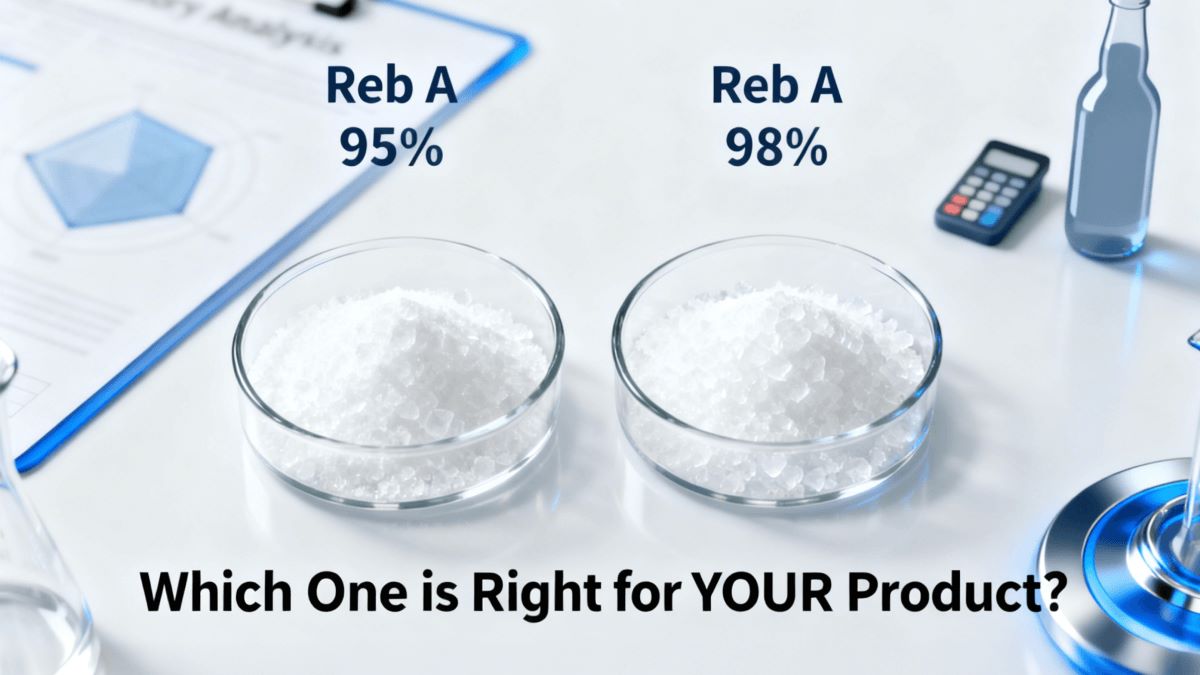Introduction: Beyond the Purity Percentage
For food and beverage manufacturers formulating with natural sweeteners, the choice of stevia extract often comes down to two common benchmarks: Reb A 95% and Reb A 98%. While the 3% purity difference might seem negligible at first glance, it carries significant implications for taste, cost, and application suitability. Choosing the right grade is not about which one is "better" in absolute terms, but which one is optimal for your specific product. This guide will delve into the technical and economic distinctions to empower you to make the most informed decision.
The Common Ground: Understanding the Basics
First, it's crucial to understand what you're buying. Both Reb A 95% and Reb A 98% are forms of high-purity Steviol Glycosides Powder. They are derived from the stevia leaf through a process of extraction and purification, resulting in a white, crystalline powder that is 200-300 times sweeter than sucrose. Both grades meet major global food safety standards (JECFA, FDA GRAS, EFSA), making them suitable for international markets. The core difference lies in the concentration of the most desirable glycoside, Rebaudioside A, and the profile of the remaining 2-5% of other glycosides, primarily Stevioside.
The Key Differentiator: A Matter of Taste and Trace Components
The primary driver behind the choice is the sensory profile.
- Reb A 98% (The Purity Benchmark): This grade represents the pinnacle of refinement. The higher concentration of Reb A and the consequent reduction in other minor glycosides result in the cleanest, sweetest taste with the least perceptible bitterness or licorice aftertaste. It is specifically engineered for applications where a neutral sweetness is critical to the product's flavor integrity.
- Reb A 95% (The Industry Workhorse): This is the most widely adopted grade for a reason. It offers an excellent, clean sweetness that is more than sufficient for a vast majority of applications. It may have a marginally more pronounced sensory profile compared to the 98% grade, but this is often undetectable, especially in complex or flavored products. The remaining glycoside fraction can contribute to a fuller sweetness profile.
Application-Based Selection: Matching the Grade to Your Product
Your product category is the most important factor in this decision.
Choose Reb A 98% for:
- Clear Beverages & Flavored Waters: These products have nowhere for off-notes to hide. The impeccable cleanliness of Reb A 98% is essential for achieving a sugar-like taste in a simple matrix.
- White Milk & Neutral Dairy Products: Similar to clear beverages, the delicate flavor of plain milk and some yogurts is easily overshadowed by any subtle aftertaste.
- High-End, Light-Colored Products: Where a pristine sensory experience is a key brand promise.
Choose Reb A 95% for:
- Acidic Beverages (e.g., Sodas, Juices): The acidity and robust flavoring systems effectively mask the minimal difference in aftertaste.
- Dairy Products with Strong Flavors (e.g., Strawberry Yogurt, Chocolate Milk): The added flavors dominate the sensory profile, making the premium for 98% unnecessary.
- Confectionery, Bakery, and Sauces: The complex matrices involving fats, proteins, and spices, along with thermal processing, make the 95% grade a perfectly effective and cost-efficient sweetener.
- Nutritional Supplements & Health Products: Where the focus is on sugar reduction and the product's base has its own inherent flavor.
The Cost-Benefit Analysis: Balancing Purity and Price
This is where the decision becomes a clear business calculation. Reb A 98% commands a higher price per kilogram due to the more intensive purification required to achieve those extra percentage points. However, the critical question is: does your product formulation require that level of purity to succeed in the market?
For many manufacturers, Reb A 95% delivers 95% of the performance at a significantly lower cost-in-use. The savings can be substantial when scaling up to bulk production, directly improving your profit margins without compromising on product quality or consumer acceptance. Investing in the 98% grade without a clear sensory justification is an unnecessary cost.
Conclusion and Next Steps: Partner with Your Supplier
There is no one-size-fits-all answer. The right choice hinges on a careful evaluation of your product's flavor matrix, target consumer, and cost structure.
Our Recommendation:
- If your product has a simple, delicate flavor profile, the investment in Reb A 98% is likely justified.
- For the vast majority of flavor-rich, complex, or cost-sensitive applications, Reb A 95% provides the ideal balance of performance and value.
The best way to make a final decision is through practical testing. We encourage you to evaluate both grades in your specific product. As a leading stevia extract supplier, we offer both Reb A 95% and Reb A 98% powders and provide comprehensive technical data to guide your selection.
Ready to formulate with the right stevia? Contact our technical team today to request samples and a competitive quote tailored to your production needs.

